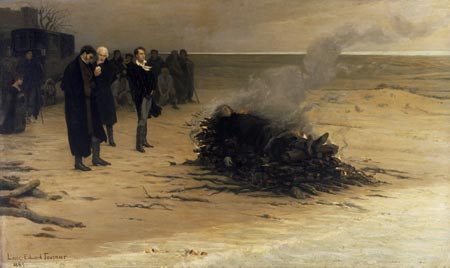
Louis Edouard Fournier, The Funeral of Shelley
In a grad school class I once heard Peter Lehmann, a friend of Virginia and Leonard Woolf, say that, during the London blitzkrieg of 1940-41, all the London bookshops sold out their poetry. This means, I think, that in times of tragedy we turn to poetry for solace. It’s like the way that people who haven’t been to church in years return following a crisis.
As a literature teacher I had not, of course, absented myself from poetry at the time Justin died, but I found myself turning to my book shelves with a new urgency. Among other poems, I especially found myself checking out the great elegies to see whether they could in fact offer comfort.
Milton’s “Lycidas” had some lines that struck home, such as “Where were ye, Nymphs, when the remorseless deep/Closed o’er the head of your loved Lycidas?” But “Lycidas” did not do as much for me as I thought it would, given that its subject, Milton’s college classmate Edward King, was, like Justin, a young man with great promise who died in a drowning accident. Instead, I found myself having the response that Samuel Johnson had to the poem: “Lycidas” seemed more interested in other things, or too trapped in its genre (the pastoral elegy), to touch me. Johnson has been widely attacked for his criticism of the poem, and I’m not saying that he’s right—just that, when I needed a poem, this one did not ultimately work for me.
But its genre couldn’t have been the problem because another pastoral elegy was in fact able to penetrate my state of shock. Shelley wrote Adonais to mourn the death of poet John Keats, who died tragically young . Normally I find Shelley’s high romanticism a bit rich for my blood, but his confident assertions provided a comfort. “Peace, peace! He is not dead, he doth not sleep–/He hath awakened from the dream of life” stirred a hope that all had not ended. So did the opening line of the following stanza, “He hath outsoared the shadow of our night.”
But it was the lines from a few stanzas later that most caught at my throat: “He is a portion of that loveliness/Which once he made more lovely.”
As I read this passage, I thought of Justin returning to nature, which for me is both material and spiritual. Guided by this vision, we scattered half of his ashes in the river where he drowned and buried the rest under a marker in the cemetery that overlooks the spot. On the marker’s brass plaque we had inscribed an excerpt from the preceding stanza, and we set up a bench so that people could read it and look out over the river. The lines are these:
He is made one with Nature: there is heard
His voice in all her music, from the moan
Of thunder, to the song of night’s sweet bird;
He is a presence to be felt and known
In darkness and in light, from herb and stone
I hoped that people would sit on the bench, look out over the beauty that had once given Justin so much joy—a beauty that he was now part of—and move beyond their cares and their fear of death. Since the cemetery is next to the college campus, I imagined that many of them would be students like Justin.
To be sure, I knew they would not have the specific associations that Shelley has: Shelley knows that, from now on, when he hears a nightingale he will hear Keats’s voice, the poet having succeeded in making “night’s sweet bird” more lovely through his poem “Ode to a Nightingale.” By contrast, Justin is not “a presence to be felt and known” in the same way. But the epitaph suggests to the casual visitor that something of this 21-year-old, some immaterial presence, may still infuse the place. Reading the poem while gazing at the river, one is can imagine that this young man and natural beauty and art and higher mystery are all bound up together and present.
I have material evidence for this belief. Struck by the last line of the passage, people began bringing sprigs of heather and small stones shortly after the marker was laid. These were undoubtedly people who knew and loved Justin, and for a year or so it was not uncommon for me to see them sitting on the bench after having made their offering. But offerings continue to be made nine years later, even though most who visit the site do not know who Justin was. The sprigs and stones have given way to oyster shells from the beach, which are now always to be found framing the poem. These, in turn, have drawn small children, and I have heard from a number of parents that this marker is a favorite because of the shells. I find this very meaningful because Justin had a special bond with children. It is as though he is still playing with them.
A passage that came to my support at a dark time now supports and guides others. This is not something to be taken lightly.


One Trackback
[…] told the story of how we placed a bench by the gravesite so that friends, students, and other visitors could look […]